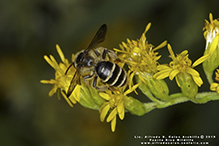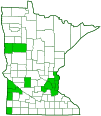cloudy-winged mining bee
(Andrena nubecula)
Conservation • Description • Habitat • Ecology • Distribution • Taxonomy
Conservation Status |
|
|||||||
| IUCN Red List | not listed |
|||||||
| NatureServe | NNR - Unranked SNR - Unranked |
|||||||
| Minnesota | not listed |
|||||||
Description |
||
Cloudy-winged mining bee is a small, easily recognized, late season, mining bee. It occurs in the United States east of the Rocky Mountains, and in southern Canada. It appears in late summer when its preferred pollen sources, goldenrods, asters, meadowsweet, and yellow sweet clover, are in bloom. Females are 5⁄16″ to ⅜″ (8 to 9 mm) long. There are two large compound eyes on the sides of the head and three simple eyes (ocelli) in a triangle on top of the head. The compound eyes are distinctly vertical. The inner margins are straight up and down and close to parallel. Next to the inner margin of each compound eye there is a slight depression (fovia) out of which emerges a dense band of pale hairs. The face is wider than long and nearly oval. The tongue is short and pointed. The antennae have 10 segments (flagellomeres) beyond the scape and pedicel. There are two grooves (subantennal sutures) below the base of each antenna, though these cannot be seen without careful handling and possibly also a microscope. The head and thorax are covered with short, erect, pale hairs. The hairiness is thin, and does not hide the surface. The exoskeletal plate covering the first segment of the thorax (pronotum) is short and collar-like. There is a rounded lobe on each side of the pronotum that does not reach the small plate covering the wing base (tegula). The plate on the upperside of the large middle segment (mesonotum) is entirely black with no yellow markings. The abdomen has 6 segments. It is smooth, black, and dull, with no yellow markings. There is a conspicuous, dense band of erect whitish hairs at the rear margin of segments 2 through 4. Segment 5 has longer, brownish hairs. The forewings are mostly clear but moderately tinged with brown between the marginal cell and the wingtip (apex). The marginal cell is relatively long and is rounded at the tip. There are three submarginal cells. The second submarginal cell is much shorter than the first and third. The basal and second recurrent veins are nearly straight. The broad lobe at the base of the hindwing (jugal lobe) is longer than the narrow cell adjacent to it (submedian cell). At the base of each hind leg there is a tuft of long, thick, pollen-collecting hairs (scopa). The hairs on the legs are entirely pale. On the hind legs the second segment (trochanter) has a tuft of long, thick, pollen-collection hairs (scopa) on the underside. The fourth segment (tibia) is densely covered with long, thin, yellowish hairs (also scopa) that are minutely feather-like (plumose). Males are smaller, ¼″ (6 mm) long. The hairs on the head and thorax are moderately long. The antennae have 11 flagellomeres. The abdomen has 7 segments. The hair bands on the abdomen are less conspicuous. The legs have no scopa. |
||
Size |
||
Female: 5⁄16″ to ⅜″ (8 to 9 mm) Male ¼″ (6 mm) |
||
Similar Species |
||
Habitat |
||
|
||
Ecology |
||
Season |
||
One generation per year: August to October |
||
Behavior |
||
|
||
Life Cycle |
||
The female creates a vertical tunnel in the ground with side tunnels branching off. Each side tunnel is a cell containing a single egg and provisioned with a ball of pollen mixed with nectar. |
||
Larva Food |
||
Pollen and nectar |
||
Adult Food |
||
Pollen of goldenrods, asters, meadowsweet, and yellow sweet clover |
||
Distribution |
||||
|
||||
| 8/8/2022 | ||||
Occurrence |
||||
|
||||
Taxonomy |
|||
Order |
Hymenoptera (Ants, Bees, Wasps, and Sawflies) | ||
Suborder |
Apocrita (Narrow-waisted Wasps, Ants, and Bees) | ||
Infraorder |
Aculeata (ants, bees, and stinging wasps) | ||
Superfamily |
Apoidea (bees and apoid wasps) | ||
| Epifamily | Anthophila (bees) | ||
Family |
Andrenidae (miner, fairy, allied panurgine, and oxaeine bees) | ||
Subfamily |
Andreninae (typical mining bees) | ||
Tribe |
Andrenini | ||
Genus |
Andrena (mining bees) | ||
| Subgenus | Cnemidandrena | ||
Synonyms |
|||
|
|||
Common Names |
|||
cloudy-winged mining bee smoke-tip mining bee |
|||
Glossary
Flagellomere
A segment of the whip-like third section of an insect antenna (flagellum).
Ocellus
Simple eye; an eye with a single lens. Plural: ocelli.
Pronotum
The exoskeletal plate on the upper side of the first segment of the thorax of an insect.
Scopa
A brush-like tuft of hairs on the legs or underside of the abdomen of a bee used to collect pollen.
Tibia
The fourth segment of an insect leg, after the femur and before the tarsus (foot). The fifth segment of a spider leg or palp. Plural: tibiae.
Visitor Photos |
|||||
Share your photo of this insect. |
|||||
| This button not working for you? Simply email us at info@MinnesotaSeasons.com. Attach one or more photos and, if you like, a caption. |
|||||
Alfredo Colon |
|||||
 |
|||||
MinnesotaSeasons.com Photos |
|||||
|
|||||

Visitor Videos |
|||
Share your video of this insect. |
|||
| This button not working for you? Simply email us at info@MinnesotaSeasons.com. Attach a video, a YouTube link, or a cloud storage link. |
|||
Other Videos |
|||

Created: 8/8/2022
Last Updated:




